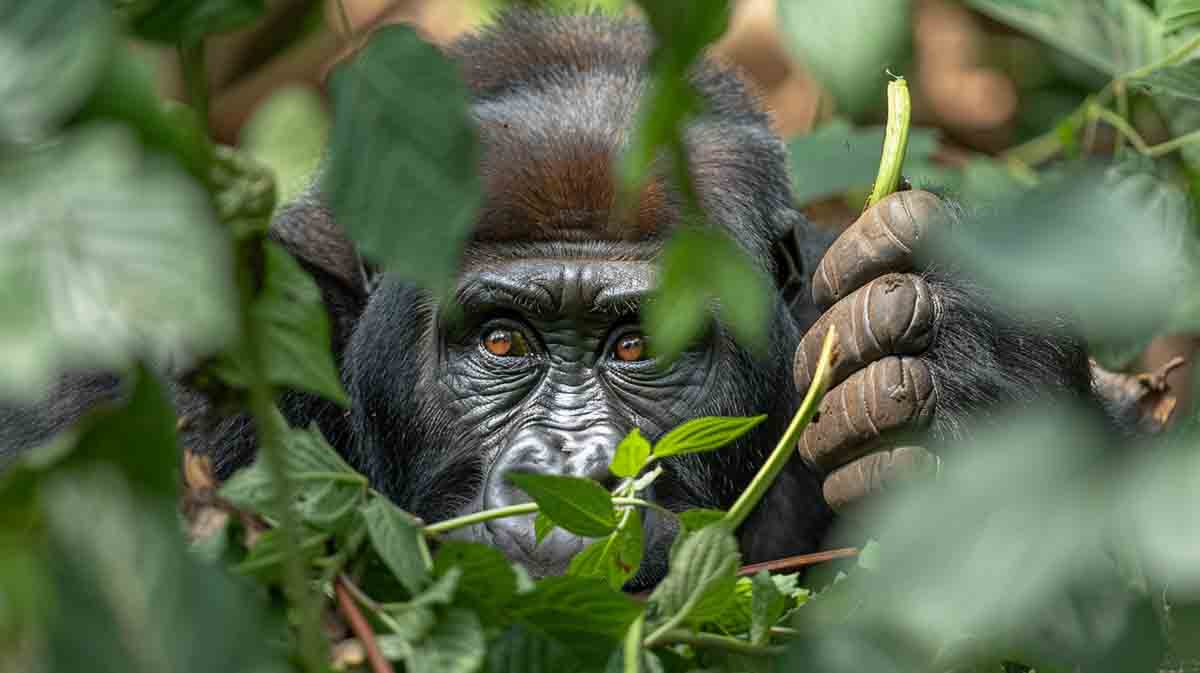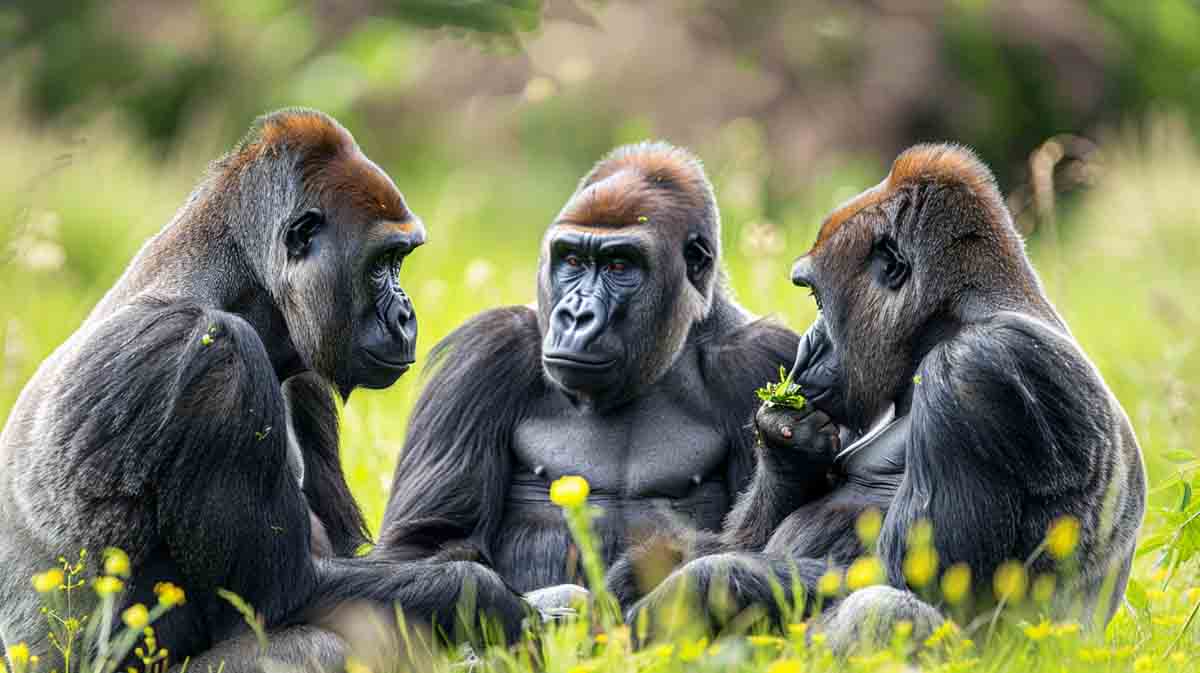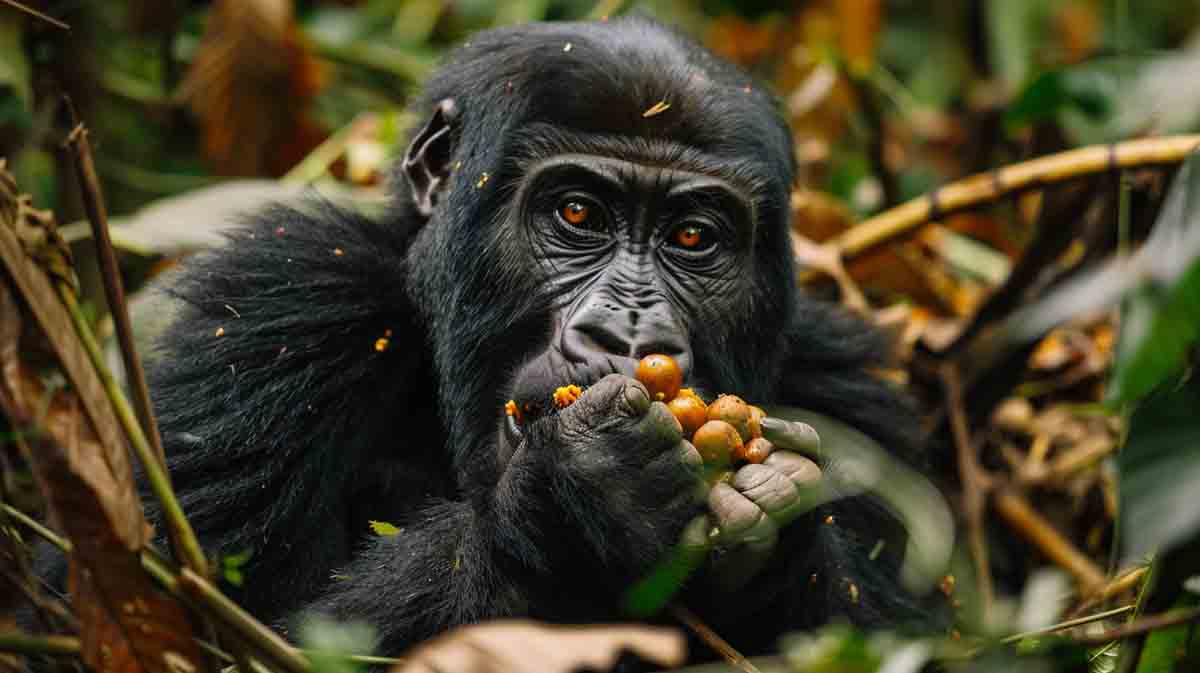Did you know that gorillas, renowned for their herbivorous diet, consume meat and even monkeys? While they primarily feast on plant-based foods, including leaves, stems, bark, flowers, and fruits, gorillas display omnivorous behaviour. This unexpected fact sheds light on the fascinating dietary habits of these remarkable creatures and raises questions about their classification as primarily herbivorous. In this article, we will delve into the intricate details of the gorilla diet, encompassing their digestive system, dietary habits, and the implications of meat consumption on their behaviour and overall health.
Key Takeaways:
- Gorillas, known for their herbivorous diet, consume meat, including monkeys.
- The gorilla diet primarily consists of plant-based foods like leaves, stems, bark, flowers, and fruits.
- Observations of gorillas consuming meat challenge the notion of their classification as primarily herbivorous.
- Gorillas’ omnivorous behaviour helps them adapt to different environments and meet their nutritional needs.
- Exploring the gorilla diet provides insights into their digestive system, dietary habits, and impact on ecosystems.
What is the Diet of Gorillas?
Gorillas have a diverse diet that consists of both plant and animal foods. Although their diet is predominantly plant-based, they are classified as omnivores. Let’s explore the various aspects of the gorilla diet, including their digestive system, dietary habits, and the differences between captive and wild gorilla diets.

Gorilla’s Digestive System and Diet Composition
Gorillas’ digestive systems are adapted to handle various plant foods. They have large, complex stomachs with multiple chambers, enabling them to efficiently break down fibrous plant material. This allows gorillas to extract the nutrients they need from their predominantly vegetarian diet.
Types of Gorillas and Their Dietary Habits
Gorillas can be divided into different types based on their location, such as lowland and mountain gorillas. Each type has its dietary habits. For example, Western lowland gorillas primarily consume vegetation, including leaves, stems, bark, and fruits. Eastern lowland gorillas have a more plant-specific diet, consuming mainly herbs and bamboo shoots.
Gorillas as Omnivores: Balancing Plant and Animal Consumption
While gorillas are primarily herbivores, they also incorporate insects and small animals into their diet. Insects, such as ants and termites, form a significant part of their diet, providing a source of protein. Gorillas have also been observed consuming meat, such as monkeys, although these instances are rare and not a significant part of their diet.
Variation in Gorilla Diet Based on Geographical Locations
Gorilla diets can vary based on their geographical locations. Factors such as food availability, climate, and the composition of the ecosystem all influence the types and quantities of food that gorillas consume. This variation in diet allows gorillas to adapt to different environments and ensure their nutritional needs are met.
Comparing Captive Gorilla Diets with Those in the Wild
Comparisons between captive gorilla diets and those in the wild offer valuable insights into the impact of captivity on their dietary habits and nutritional needs. In captivity, gorillas have a controlled diet that aims to replicate their natural diet as closely as possible. However, the availability and variety of foods may differ from what wild gorillas consume. Studying these differences can help improve captive gorilla care and enhance conservation efforts.
Do Gorillas Eat Meat?
Understanding Gorillas’ Carnivorous Behavior: Hunting and Consumption
Gorillas, primarily known for their herbivorous diet, have been observed displaying carnivorous behaviour, indicating their capability to consume meat. While rare, these instances provide valuable insights into the gorillas’ dietary flexibility.

Insects, Small Animals, and the Occasional Monkey: Exploring Meat in Gorilla Diet
In addition to plant-based foods, gorillas incorporate various forms of meat into their diet. This includes insects, such as termites and ants, which are an essential source of protein. Gorillas have also been observed consuming small animals like lizards and, occasionally, even monkeys.
Debate over Gorillas as Primary Herbivores or Omnivores
There is ongoing debate regarding categorising whether gorillas are classified as primary herbivores or true omnivores. The significance and frequency of meat consumption in their diet contribute to this discussion. While gorillas primarily consume plant-based foods, evidence of meat consumption challenges the notion of strict herbivory.
Observations of Gorillas Consuming Meat in the Wild
Observations of gorillas in the wild consuming meat provide valuable insights into their natural behaviour and dietary patterns. These observations help us better understand gorillas’ nutritional needs and dietary adaptations in their natural habitats.
The Role of Meat in the Nutritional Needs of Gorillas
While meat is not a primary food source for gorillas, it may help them meet specific nutritional requirements, particularly protein intake. Understanding the role of meat in the gorilla diet contributes to our knowledge of their dietary flexibility and overall nutritional balance.
How Does the Diet of Gorillas Affect Their Behavior and Health?
Gorillas’ omnivorous diet can have various effects on their health and development. Proper nutritional balance is essential for their overall well-being.

Effects of Omnivorous Diet on Gorillas’ Health and Development
Gorillas’ omnivorous diet plays a crucial role in their health and development. By consuming a balanced mix of plant and animal foods, gorillas obtain essential nutrients and vitamins for growth, muscle development, and overall physical well-being. The diverse diet ensures they receive a range of macronutrients and micronutrients that contribute to their overall health and vitality.
Additionally, the fibre-rich plant material in their diet promotes proper digestion and helps prevent gastrointestinal issues, keeping their digestive system in good health.
Behavioural Patterns Linked to Meat Consumption in Gorillas
While gorillas’ primary diet consists of plant matter, including leaves, stems, and fruits, occasional meat consumption can influence their behaviour. Animal protein consumption may increase energy levels and more intense physical activity, even in small quantities. Gorillas that consume meat may exhibit more robust hunting patterns and engage in more active social interactions within their groups.
Integrating Omnivorous Behavior into Gorillas’ Social Structures
Gorilla social structures are complex and highly organised, with dominant males leading the groups. Integrating omnivorous behaviour, including occasional meat consumption, can shape their social dynamics. The availability of meat may impact breeding dynamics and hierarchical structures within gorilla groups. The consumption of animal protein may enhance the physical strength and dominance of specific individuals, which can influence their position within the group hierarchy.
Macronutrient Balancing in Gorilla Diets: The Role of Protein from Meat
Protein is an essential macronutrient for gorillas, contributing to muscle development, tissue repair, and overall growth. While plant-based proteins form the bulk of their diet, occasional meat consumption can provide additional protein and help meet their nutritional needs. The protein obtained from meat assists in balancing macronutrients, ensuring gorillas receive an adequate amount of this vital nutrient for optimal health and development.
Impact of Gorilla Diet on Their Surrounding Ecosystems
The gorilla diet has a significant impact on the surrounding ecosystems. Gorillas are vital as seed dispersers, aiding forest regeneration and maintaining biodiversity. Their consumption of vegetation contributes to vegetation control, preventing overgrowth that can hinder the growth of other plant species. By influencing the distribution of plant seeds, gorillas shape the composition and structure of their habitat, ultimately impacting the balance and functioning of the ecosystem.
Are Gorillas Natural Hunters?
Though not known for their hunting prowess, Gorillas exhibit intriguing hunting behaviour and techniques that provide valuable insights into their abilities and adaptations. While they primarily rely on a plant-based diet, instances of gorillas capturing and consuming prey have been observed, suggesting their potential for hunting, albeit on a limited scale.
Exploring Gorillas’ Hunting Behavior and Techniques
Gorillas employ various hunting behaviours and techniques when pursuing prey. These include stealthy movements, strategic positioning, and precise timing to maximise their chances of a successful hunt. Although their hunting skills may not match those of other carnivorous animals, such as lions or cheetahs, gorillas demonstrate remarkable adaptability in their approach to capturing prey.
Instances of Gorillas Capturing and Consuming Prey
While most of a gorilla’s diet consists of plant material, there have been reported instances of gorillas hunting and consuming small animals. Observations have included gorillas capturing rodents, birds, and even monkeys when they can. These rare events provide compelling evidence that gorillas possess the ability to engage in hunting behaviour.
Social Dynamics in Gorilla Groups and Their Implications on Hunting
The social dynamics within gorilla groups play a significant role in their hunting behaviour. Gorillas live in cohesive family units led by an alpha male, a silverback. Cooperation and coordination among group members increase the chances of a successful hunt. This social structure also allows for transmitting hunting knowledge and techniques across generations.
Comparison of Gorilla Hunting Behavior with Other Primate Species
Comparisons between gorilla hunting behaviour and other primate species shed light on the unique evolutionary context of gorillas’ hunting abilities. While gorillas are not regarded as apex predators like some primate species, such as chimpanzees, their hunting behaviour showcases their resourcefulness and adaptability in varying ecological niches.
Implications of Hunting Behavior in Gorilla Conservation and Management
Gorillas’ hunting behaviour has significant implications for their conservation and management. Understanding their hunting behaviour can inform strategies for their protection and ensure their long-term survival. Conservation efforts must consider the complex relationship between gorillas and their natural prey to preserve these intriguing hunting behaviours.
In conclusion, although gorillas are not considered natural hunters, their hunting behaviour and techniques provide valuable insights into their adaptability and resourcefulness. Gorillas’ instances of capturing and consuming prey and their unique social dynamics highlight the complexity of their ecological niche. Understanding gorillas’ hunting behaviour is vital for their conservation and management, ensuring their survival in changing environments and threats.
What are the Implications of Gorillas Consuming Meat and Animal Products?
Meat consumption by gorillas has important implications for their nutritional adaptations and overall dietary balance. While gorillas are primarily herbivores, consuming an omnivorous diet allows them to obtain essential nutrients, such as protein, that may be limited in their plant-based diet. Meat is a valuable source of protein for gorillas, supporting their growth, development, and overall health. By including animal products in their diet, gorillas can meet their nutritional needs more effectively.
Gorillas’ omnivorous behaviour also significantly shapes ecosystem functions. Primary seed dispersers contribute to maintaining and regenerating plant species in their habitats. Their consumption of plant and animal matter, including meat, influences vegetation control and promotes biodiversity. Understanding the ecological role of gorillas as omnivores is crucial for conservation efforts to preserve their habitats and the overall health of ecosystems.
Debates arise regarding captive gorillas’ meat diets due to ethical and environmental considerations. Some argue that providing meat to captive gorillas is necessary to replicate their natural dietary patterns and ensure their well-being. However, others raise concerns about the impact of meat production and its associated environmental costs. Balancing the ethical considerations of gorilla welfare with environmental sustainability is a topic of ongoing discussion in captive gorilla management.
Understanding gorilla omnivorous diets can enhance conservation efforts and management strategies. Conservation initiatives can better support gorilla populations and promote their long-term survival by considering their nutritional needs and behavioural patterns. This includes ensuring access to a varied diet that includes plant- and animal-based food sources, considering the ecological importance of their omnivorous behaviour.
Studying gorillas’ omnivorous dietary patterns provides valuable insights into their behaviour and evolution. By analysing their consumption of meat and animal products, researchers can better understand gorilla ecological niches, adaptations, and their role in the evolutionary history of primates. These insights contribute to our broader understanding of primate evolution and inform conservation efforts to protect gorillas and their habitats.
FAQ
Do gorillas eat meat?
Yes, gorillas are primarily herbivorous, but they occasionally consume insects and small animals, making them omnivores.
What do gorillas eat?
Gorillas mainly consume plants such as leaves, stems, and fruits. However, they also occasionally eat insects, and in rare instances, they have been observed eating small animals like monkeys.
Are gorillas carnivores or omnivores?
Gorillas are considered omnivores as they consume plants and animals, although most of their diet is herbivorous.
Do gorillas ever hunt other animals?
While gorillas are not natural hunters, there have been documented instances of gorillas hunting and eating small animals like monkeys and occasionally even insects.
What is the diet of gorillas?
Gorillas’ diet primarily consists of vegetation such as leaves, shoots, fruits, and stems, but they are also known to occasionally eat insects and small animals.
Do gorillas eat monkeys?
Gorillas have been observed eating monkeys on rare occasions, but it is not a standard or regular part of their diet.
Are gorillas known to eat meat?
Yes, gorillas occasionally consume small animals like monkeys and insects, showing they have some capacity for a carnivorous diet alongside their herbivorous one.
Can gorillas be considered omnivores?
Yes, gorillas can be considered omnivores as they occasionally consume both plants and animals, although most of their diet is vegetarian.
Where do gorillas get their food from?
Gorillas get their food from the vegetation in their habitats, including leaves, stems, fruits, and other plant materials. They may also forage for insects and small animals to supplement their diet.
Do gorillas ever consume insects or small animals?
Yes, gorillas are known to consume insects occasionally, and they have been observed eating small animals like monkeys, demonstrating their capacity for an omnivorous diet alongside their herbivorous one.
